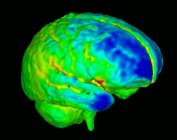Difference between revisions of "DBP2:UNC"
| (45 intermediate revisions by 8 users not shown) | |||
| Line 1: | Line 1: | ||
| − | Back to [[DBP2]] | + | Back to [[DBP2:Main|NA-MIC DBP 2]] |
| + | __NOTOC__ | ||
| + | = Overview of UNC DBP 2 = | ||
| + | == Longitudinal MRI study of early brain development in neuropsychiatric disorder: UNC Autism Study == | ||
| − | + | There is a lack of appropriate tools for processing of pediatric MRI, a challenging topic since pediatric MRI differs significantly from adult MRI due to variable brain shape and the process of maturation/myelination which are reflected in nonlinear shape/volume changes but also regional change of white matter. Working on a toolkit for the community would have a large impact, in particular also in view of existing and soon to be available databases of normative pediatric MRI (PI Alan Evans). Access to the UNC longitudinal pediatric MRI data representing a period of moderate but significant brain growth can spawn off interesting new software methodology developments from Core-1. Besides existing multi-modal MRI data, the UNC group has a very large set of segmented data (subcortical structures measured with very high reliability (0.92 up to 0.99) for over 140 MRI data sets(hippocampus, amygdale, putamen, pallide globe, caudate, ventricles) - to our knowledge the largest segmentation database of such high quality. These data could be used for shape analysis of growth trajectory and can also serve as a benchmark for novel semi-automated processing. The group has profound experience with the development of novel segmentation protocols (http://www.psychiatry.unc.edu/autismresearch/MRI_PAGE.htm) and the design of large-scale validation of segmentation methodology (see Yushkevich et al., 2006, NeuroImage, http://dx.doi.org/10.1016/j.neuroimage.2006.01.015). Moreover, the groups experience with state-of-the-art ITK/vtk processing tools will help to critically assess and improve the NA-MIC toolkit’s development from the viewpoint of users involved in large clinical studies. The processing of a relatively large database needs highly automated processing “pipelines”, i.e. co-registration of multi-modal data, atlas-to-template registration, automatic tissue segmentation, lobe parcellation, MRI-DTI registration, ROI analysis, and statistical analysis. This data therefore would be an excellent testbed for new automated Slicer 3 processing. A growth-rate analysis might have to include new methods for longitudinal image analysis, cortical thickness and cortical folding pattern analysis, methods not yet developed for the NA-MIC toolkit but required for human brain studies. [[DBP2:UNC:Introduction|More...]] | |
| − | + | Data is provided at the following link: '''[[Data:DBP2:UNC|UNC Data]]'''. | |
| − | |||
| − | |||
| − | |||
| − | |||
| − | + | = UNC Roadmap Project = | |
| − | + | {| cellpadding="10" border="1" style="background:lightblue;text-align:left;" | |
| − | + | |style="width:15%" | [[Image:BrainDevelopment.jpg|200px]] | |
| + | |style="width:85%" | | ||
| − | + | == [[DBP2:UNC:Cortical_Thickness_Roadmap|Cortical Thickness for Autism]] == | |
| + | |||
| + | Our goal is to begin a longitudinal study of early brain development by cortical thickness in autistic children and controls (2 years with follow-up at 4 years). We want to be able to make statistical group comparisons. [[DBP2:UNC:Cortical_Thickness_Roadmap|More...]] | ||
| + | |||
| + | <font color="red">'''New: '''</font> Participation in the NA-MIC Winter 2010 Project Week. | ||
| + | |||
| + | |} | ||
Latest revision as of 20:20, 15 January 2010
Home < DBP2:UNCBack to NA-MIC DBP 2
Overview of UNC DBP 2
Longitudinal MRI study of early brain development in neuropsychiatric disorder: UNC Autism Study
There is a lack of appropriate tools for processing of pediatric MRI, a challenging topic since pediatric MRI differs significantly from adult MRI due to variable brain shape and the process of maturation/myelination which are reflected in nonlinear shape/volume changes but also regional change of white matter. Working on a toolkit for the community would have a large impact, in particular also in view of existing and soon to be available databases of normative pediatric MRI (PI Alan Evans). Access to the UNC longitudinal pediatric MRI data representing a period of moderate but significant brain growth can spawn off interesting new software methodology developments from Core-1. Besides existing multi-modal MRI data, the UNC group has a very large set of segmented data (subcortical structures measured with very high reliability (0.92 up to 0.99) for over 140 MRI data sets(hippocampus, amygdale, putamen, pallide globe, caudate, ventricles) - to our knowledge the largest segmentation database of such high quality. These data could be used for shape analysis of growth trajectory and can also serve as a benchmark for novel semi-automated processing. The group has profound experience with the development of novel segmentation protocols (http://www.psychiatry.unc.edu/autismresearch/MRI_PAGE.htm) and the design of large-scale validation of segmentation methodology (see Yushkevich et al., 2006, NeuroImage, http://dx.doi.org/10.1016/j.neuroimage.2006.01.015). Moreover, the groups experience with state-of-the-art ITK/vtk processing tools will help to critically assess and improve the NA-MIC toolkit’s development from the viewpoint of users involved in large clinical studies. The processing of a relatively large database needs highly automated processing “pipelines”, i.e. co-registration of multi-modal data, atlas-to-template registration, automatic tissue segmentation, lobe parcellation, MRI-DTI registration, ROI analysis, and statistical analysis. This data therefore would be an excellent testbed for new automated Slicer 3 processing. A growth-rate analysis might have to include new methods for longitudinal image analysis, cortical thickness and cortical folding pattern analysis, methods not yet developed for the NA-MIC toolkit but required for human brain studies. More...
Data is provided at the following link: UNC Data.
UNC Roadmap Project

|
Cortical Thickness for AutismOur goal is to begin a longitudinal study of early brain development by cortical thickness in autistic children and controls (2 years with follow-up at 4 years). We want to be able to make statistical group comparisons. More... New: Participation in the NA-MIC Winter 2010 Project Week. |